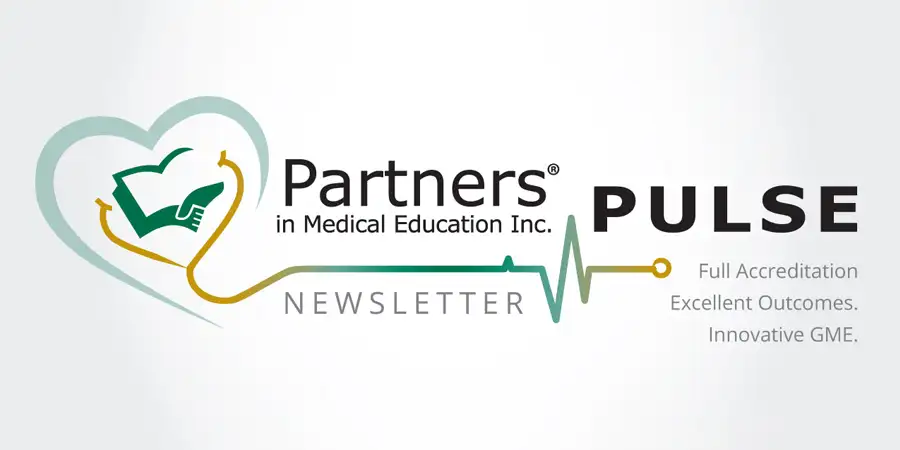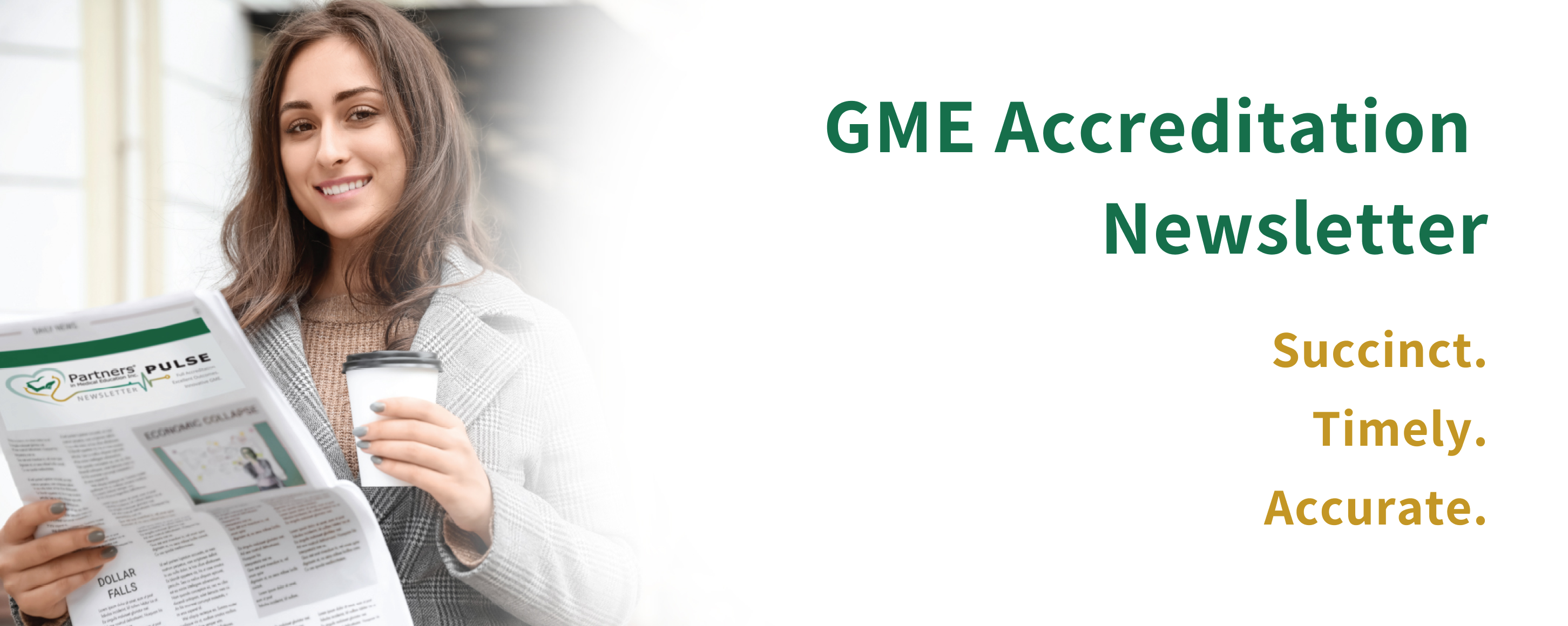Jump to Article
Sponsoring Institution
Program
GME Office / Administration
Finance / Public Policy

Sponsoring Institution
By: Cheryl Haynes, BA Cheryl@PartnersInMedEd.com
The Process of the Institutional Self-Study and 10-Year Site Visit: What to Expect
While some of us breathed a sigh of relief when the ACGME announced that they would no longer conduct 10-Year Site Visits for programs, those of us who work at the institutional level weren’t so lucky. In addition to the site visit itself, institutions must complete a prior Self-Study. As with most things, planning, understanding the requirements, and paying attention to details are crucial.
Institutions will receive a notice from the ACGME to perform the Self-Study six months before the due date. Just like annual updates and other site visits, the completed form is uploaded into ADS. Institutions can expect their 10-Year Site Visit to be scheduled approximately 24 months after the Self-Study is submitted.

Start planning your Self-Study Team as soon as possible. The DIO should assemble this team and include at least the following:
1. A member of the senior administration to address strategic planning for GME at your institution.
2. Residents/Fellows who serve on the GMEC
3. Faculty Members
4. Institutional and/or Program Coordinators
5. Clinical Leaders
6. Representatives of other Health Professions
As with all things related to Graduate Medical Education, document, document, document!! We recommend that you keep separate, specific records of everything related to the Self Study.
The work of the Self-Study Team will focus on your institution’s mission and aims and how well its performance meets that mission. It will include an analysis of the institution’s strengths, areas of concern, opportunities and challenges to meet their defined aims. Specific data that should be reviewed in this study include the institution’s resources, processes, activities, and policies. After completing their analysis, the team will identify specific actions the institution should take to ensure their identified aims are met.
To complete this study, the team must complete the provided Institutional Self Study Form that is available on ADS. Again, this form must be submitted via ADS six months after the notification to perform the study.
The next step in this process is the 10-Year Institutional Site Visit. Your first indication will be the receipt of a request from the ACGME to submit black-out dates. Shortly thereafter, the ACGME will notify you of the date of your site visit and the Field Representative(s) who will conduct it. ADS provides you with the details of the information to be updated and documents required to be uploaded. Your Field Representative(s) will also communicate any additional information that they require as well as provide an agenda for the site visit and inform you as to whether it will be conducted virtually or in person.
Remember that the Field Representatives are fact-finders. They will conduct the visit and then report their findings to the Institutional Review Committee, which will make the final accreditation decision. Check the ACGME website for the IRC’s meeting schedule to get an idea of when you can expect to receive that decision.
Again, read the instructions, follow them explicitly and pay attention to details! Remember that we are here to help you in this process.

Program
By: Christine Redovan, MBA, MLIS Christine@PartnersInMedEd.com
Refreshing Your Clinical Competency Committee (CCC)
It’s hard to believe that the Clinical Competency Committee (CCC), the ACGME required, twice a year discussion of resident progress in our training programs turns 11 years old this year. Pre-teen drama aside, our CCC’s have become one of the most important faculty responsibilities playing a critical role in resident assessment. Let’s look at five ways we can refresh our CCCs.
- Do all members equally participate? All members of the CCC must speak their opinions and provide input to your residents. Chairs of CCC must allow time for everyone to actively participate. A way to ensure this is to ask for input after each resident’s presentation in a round-robin format.
- Does your CCC have an established routine in which all members coordinate activities and understand their roles? PD, CCC Chair, members, PC, and residents all have a role in the success of the CCC. Check out Al-Bualy’s (2023) infographic on Effective Clinical Competency Committee Meeting Practices: Before, During, and After for ideas.
- Are notes taken in a standard format? Having a standardized way to capture notes on the discussion will ensure that nothing is missed and provide a template for providing feedback to the resident.
- Do committee members receive updates on the feedback provided to the residents? Has the CCC closed the loop on recommended actions the resident should take? This ensures that the resident has 1) received the feedback; 2) understands that he has responsibility as part of the CCC process; and 3) informs the CCC of improvements that can be used in the next review cycle.
- Is your evaluation data providing the CCC the information they need to make informed decisions? Are your systems of providing data integrated in a way that is seamless and provides accurate, visual information that the CCC, and the resident, can understand? A recent article suggests using learning analytics to assist in improving data quality, synthesis, and analysis to better inform the CCC (Carney, 2023).
Analyzing your CCC’s processes can provide a fresh perspective, integrate all committee members, and provide structure. Do not be afraid to try new things, utilize new sources of data and get out of your comfort zone.
References
Al-Bualy, R., Ekpenyoung, A., & Holmboe, E. (2023). Effective clinical competency committee meeting practices: Before, during, and after, Acad Med. 98, 1340, DOI: 10.1097/ACM.0000000000005123.
Carney, P.A., Sebok-Syer, S.S., Pusic, M.V., Gillespie, C.C., Westervelt, M., & Goldhamer, M.J. (2023). Using learning analytics in clinical competency committees: Increasing the impact of competency-based medical education, Medical Education Online 28 (1), DOI: 10.1080/10872981.2023.2178913

GME Office / Administration
By: Carmela Meyer, MBA, EdD Carmela@PartnersInMedEd.com
One Big, Happy Family?
Residency program unionization is becoming more prevalent across the country according to a AAMCNews article in June of 2022. Resident unions can be traced back to 1934 with the Interne Council of Greater New York. Issues leading to unionization included lack of compensation, limited learning opportunities and work conditions.
In 1999, the National Labor Relations Board (NLRB) ruled that residents are considered employees of the institution only regarding issues of federal labor rules thereby possess the right to unionize. Unions may not interfere with the educational program.
Roughly 15% of residents and fellows in more than 60 hospitals are represented by CIR, part of the Service Employees International Union. Some additional residents/fellows have joined local unions or joined the Union of American Physicians and Dentists.
With the challenges brought on by COVID, resident unions increased due to work hour requirement violations, being pulled from rotations that jeopardized their education and being vaccinated as a first line provider in many hospitals.
What are the benefits and challenges of unionizing?
- Pay: Residents are paid less than other health care providers and they are required to work longer hours. Unions will not address the number of hours residents will work as it is a requirement of the ACGME, but they will work to increase resident pay. If calculated at 80 hours per week, residents are working below minimum wage.
- Rejection of 24-hour shifts for pregnant women: Unions may negotiate for preferential scheduling for wellness.
- Unions can enhance clinical work environments through programs to address bias and harassment.
- Unions can help move change forward at a faster pace.
- Pay: Hospitals are limited to the amount of reimbursement received by the Centers for Medicare and Medicaid Services (CMS). Unions and CMS funding don’t always align, adding the financial burden of hospitals.
- Strikes: threatening strikes can hold hospitals hostage and jeopardize patient care.
- Trust: some residents have communicated a concern regarding the violation of the community’s trust in providers once unionized.
- Flexibility: unionization requires equal benefits for all. Programs will not have the flexibility to allow residents additional time for personal emergencies, time to develop skills.
- Union priorities may not always be valued by 100% of the residents, yet they are approached as such.
Whether unions are beneficial to residents is not yet decided. What is clear is that more programs are considering unionizing, and it is in the best interest of GME to understand the processes and potential impact.
References
Weiner, S. (2022, June 7). Thousands of medical residents are unionizing. Here’s what that means for doctors, hospitals, and the patients they serve. Retrieved from AAMC: https://www.aamc.org/news/thousands-medical-residents-are-unionizing-here-s-what-means-doctors-hospitals-and-patients-they
Finance / Public Policy
By: Victoria Hanlon, MS Tori@PartnersInMedEd.com
Is Your Institution Capitalizing on Available GME Cap Slots?
Once a hospital has an established residency cap, it is almost impossible to get more slots. More slots = more money, and most established teaching hospitals are vying for slots when they do become available. While you may be aware of slots that become available when a hospital closes as part of the Affordable Care Act (Section 5506), you may not be as familiar with the additional 1,000 slots authorized through the Consolidated Appropriations Act of 2021 (Section 126).
The slots available through the Consolidated Appropriations Act are being distributed through a series of rounds, with each round awarding 200 slots. The first two rounds of slots have been awarded and were announced in 2023. The third round closed on March 31, 2024 and will be announced by CMS by January 31, 2025. However, there will be two more rounds in the future for which your hospital may be able to apply.
In order to qualify for these slots, hospitals must fit into at least one of four categories:
- Hospitals in rural areas
- Hospitals training a number of residents in excess of their GME cap
- Hospitals in states with new medical schools or branch campuses
- Hospitals that serve areas designated as health professional shortage areas (HPSAs)
The Act also requires that at least 10% of the cap slots go to hospitals in each of the four categories, so as to more equitably distribute slots in order to fulfill the intent of the law. Additionally, a hospital cannot receive more than 25 slots, and slots cannot be used to fund existing positions.
Partners encourages all hospitals to look into this and see if it is something yours would qualify for. Partners can also assist hospitals with this if needed. Reach out to us for help if needed. To access the application, and for more information on these slots, go to https://www.cms.gov/medicare/payment/prospective-payment-systems/acute-inpatient-pps/direct-graduate-medical-education-dgme
 |
 |
 |



